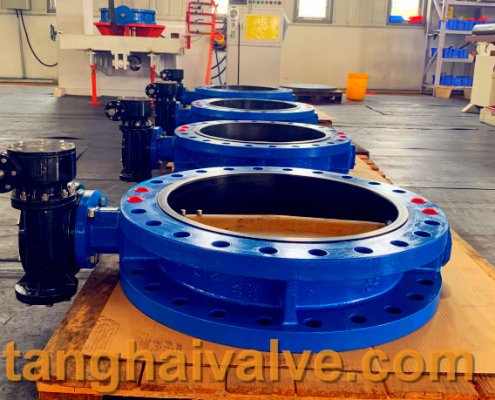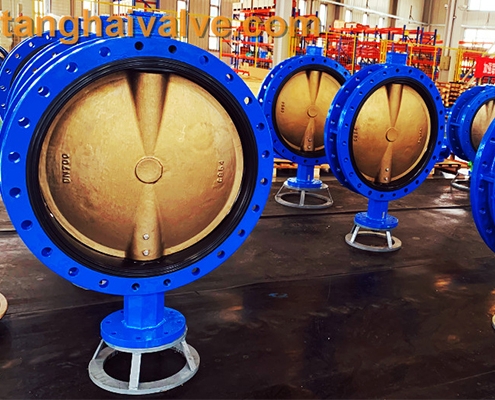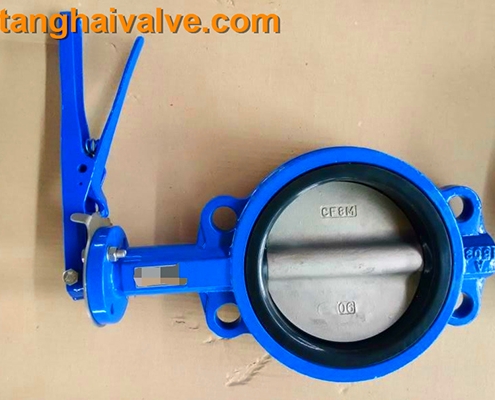How to choose the right butterfly valve (2)
However, the following problems still exist during the use of this butterfly valve:
1. Due to the multi-layer soft and hard laminated seal ring fixed on the valve plate, when the valve plate is normally open, the medium forms a frontal flush on the sealing surface. The soft sealing tape in the metal sheet interlayer is directly affected by the flushing, which directly affects the sealing performance.

U-type flange butterfly valve, ductile iron, DI, center line,
2. Restricted by structural conditions, the structure is not suitable for valves with a diameter of DN200 or less, because the overall structure of the valve plate is too thick and the flow resistance is large.
3. Due to the principle of the three-eccentric structure, the sealing between the sealing surface of the valve plate and the valve seat is caused by the torque of the transmission device to press the valve plate against the valve seat. In the positive flow state, the higher the medium pressure, the tighter the seal extrusion. When the medium in the flow channel reverses flow, as the medium pressure increases, the unit positive pressure between the valve plate and the valve seat is less than the medium pressure, and the seal begins to leak.
The high-performance triple-eccentric bidirectional hard seal butterfly valve is characterized in that the valve seat sealing ring is composed of multiple layers of stainless steel sheets on both sides of a soft T-shaped sealing ring. The sealing surface of the valve plate and the valve seat is an oblique cone structure. The surface of the oblique cone of the valve plate is welded with a temperature-resistant and corrosion-resistant alloy material; the spring fixed between the pressure plate of the adjustment ring and the adjustment bolt of the pressure plate are assembled together.
This structure effectively compensates the tolerance zone between the shaft sleeve and the valve body and the elastic deformation of the valve stem under medium pressure, and solves the sealing problem of the valve in the process of bidirectional interchangeable medium transportation. The use of soft T-shaped multi-layer stainless steel sheets on both sides to form a sealing ring has the dual advantages of metal hard seal and soft seal. It has zero leakage sealing performance at low and high temperatures.
The test proves that when the pool is in the positive flow state (the medium flow direction is the same as the disc rotation direction), the pressure on the sealing surface is generated by the torque of the transmission device and the effect of the medium pressure on the valve plate. When the positive medium pressure increases, the tighter the surface of the valve plate oblique cone and the valve seat sealing surface are pressed, the better the sealing effect. In the reverse flow state, the seal between the valve plate and the valve seat is pressed against the valve seat by the torque of the driving device. As the pressure of the reverse medium increases, the unit positive pressure between the valve plate and the valve seat is less than the medium pressure, the deformation energy stored by the spring of the adjusting ring after being loaded compensates the tight pressure of the sealing surface of the valve plate and the valve seat Play the role of automatic compensation. Therefore, unlike the prior art, the utility model does not install soft and hard multi-layer sealing rings on the valve plate, but directly installs on the valve body. It is an ideal two-way hard sealing method to add an adjustment ring between the pressure plate and the valve seat. . It will replace gate valves, globe valves and ball valves.
TH Valve is a professional manufacturer of butterfly valve, gate valve, check valve, globe valve, knife gate valve, ball valve with API, JIS, DIN standard, used in Oil, Gas, Marine industry, Water supply and drainage, fire fighting, shipbuilding, water treatment and other systems, with Nominal Diameter of DN50 to DN1200, NBR/EPDM/VITON, Certificates & Approvals: DNV-GL, Lloyds, DNV, BV, API, ABS, CCS. Standards: EN 593, API609, API6D
related news /knowledge: How to choose the right butterfly valve (1); Detailed introduction of soft sealing butterfly valve-(3); Difference between soft seal butterfly valve and hard seal butterfly valve;





 © Copyright 2020 Tianjin Tanghaidongyang Valve Co., Ltd. All Rights Reserved.
© Copyright 2020 Tianjin Tanghaidongyang Valve Co., Ltd. All Rights Reserved.